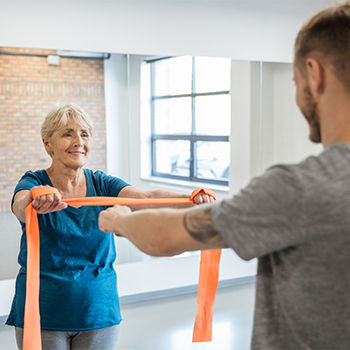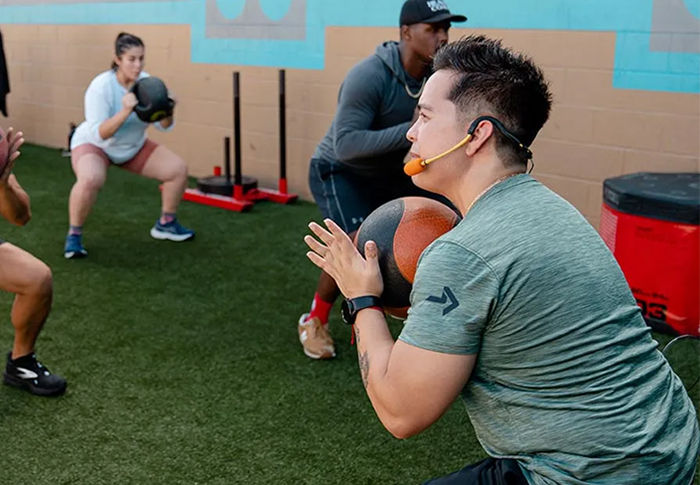|
Key Takeaways Adding cognitive challenges to exercises your clients are already performing can improve brain health alongside physical health. Here are some important takeaways from this conversation with Jonathan Ross:
Read on to learn more about exercise for brain health and strategies for helping clients who are concerned about cognitive decline. Check out the Alzheimer’s Fitness Specialist Program. |
If you have clients who have been diagnosed with, or are concerned about, cognitive decline, it’s vital that you have the appropriate skills to design fitness experiences that address not only physical health, but also brain health. By incorporating memory drills, movement-based games and brain-health coaching strategies, you can help clients move with purpose.
This is why ACE is so proud to introduce the Alzheimer’s Fitness Specialist Program, to empower you to design programs and lead exercise sessions for clients who are experiencing cognitive decline or simply want to do everything they can to age with strength and confidence. We also wanted to provide practical tools, not just theory, which is why this program features memory drills, movement-based games and brain-healthy coaching strategies that will position you and your clients for long-term success.
Jonathan Ross, the creator and instructor of the Alzheimer’s Fitness Specialist Program, is a multiple Personal Trainer of the Year Award winner, international presenter and brain fitness advocate known for translating neuroscience into energizing workouts through his Funtensity program. He is a long-time ACE partner and has collaborated with us on countless articles, webinars and programs.
Here, Jonathan answers important questions about how movement impacts brain health and how you can incorporate exercises that positively impact cognitive health into your clients’ workouts.
How can movement and exercise support brain health? Please address both those who have been diagnosed with Alzheimer’s disease as well as clients who are simply concerned about their cognitive health.
Physiologically, movement increases blood flow to the brain, and this enhances both fuel delivery and waste product removal. Movement also requires processing sensory input from the outside world, deciding what to do about it and then doing it.
More specifically, research shows that exercise improves the function of both immune system cells in the hippocampus called microglia and cells called neurovascular astrocytes (NVAs) that enhance the function of the blood-brain barrier.
These benefits accrue independent of a focus on prevention or disease management.
Are there specific types of physical activity that offer greater cognitive benefits?
Generally, contracting muscles produce numerous myokines, small strings of amino acids that regulate various metabolic processes and allow muscles to cross-talk with other organs and bodily systems.
The type of exercise determines which myokines get produced (and there is significant overlap in many exercise modalities). If humans can potentially do something, then we should train for it. That means strength and aerobic training with the addition of elements such as reactivity, coordination and balance included at times.
Additionally, modalities like high-intensity interval training (HIIT), as one example, enhance processing speed and attention.
The main takeaway: All exercise is good for the brain, but integrated cognitive and physical fitness is better. For example, trail running is better for your brain than treadmill running. If every step is placed on a unique surface with varying circumstances, it requires more processing of sensory input and decisions about exactly how to move with each step taken.
Do clients who are concerned about brain health need to perform additional exercise each week or can cognitive fitness be integrated into what they’re already doing? If it’s the latter, can you offer strategies for how to do so?
No additional exercise is necessary! Cognitive fitness not only can, but should, be integrated into some of the existing exercise pursuits.
Some simple examples:
- Use two exercises with different reps and alternate them: Dumbbell squat and shoulder press (using dumbbells)
- Perform 3 reps of the squat for every 1 rep of the shoulder press, which requires more attention and use of short-term memory. (Also, this allows for an appropriately challenging resistance for the comparatively stronger leg muscles, which will perform more reps.)
- Perform the two exercises using a sequential countdown pattern of 4-3-2-1, meaning 4 of each, then 3 of each, etc. You conclude having completed 10 reps of each. This can be done by counting down from 5 to 1 (for 15 total reps), or many other combinations of numbers.
- Count reps by 3s or 7s (harder) or 2s or 5s (easier.)
IMPORTANT: Not only is additional exercise not required, but people do not need high-tech equipment or boutique studios devoted to brain fitness. Those are nice bells and whistles but the cost is a barrier to entry to these options, meaning they will never be a viable solution for the masses.
What inspired you to create the Alzheimer’s & Brain Fitness Specialist Course and what do you hope exercise pros will take away from this course and apply in their work?
Most neurodegenerative diseases are caused—and may be prevented—by lifestyle factors under the scope of practice of exercise professionals and health coaches: physical activity, exercise, nutrition, stress management, sleep and social connection.
Secondly, presenting an exercise and physical activity model that is, by design, interactive and reactive creates a more enjoyable experience and research shows that people work harder without reporting a subjective increase in intensity. In other words, the extra effort does not feel as hard.
The population is skewing older, and this cohort has both the means—in terms of time and money—and the motivation to enhance brain function now and prevent disease later. This is a tremendous opportunity for professionals to make a living changing lives by changing people’s minds about exercise.
Is there anything else you’d like to say about this topic that we haven’t covered?
For most of human history, we had to solve problems related directly to survival in a variable and often threatening environment. This required us to think and move simultaneously. Modern life is sit still and think, think, think all day at work and then go move while often turning off our brains and performing rote, unengaging exercise. We’ve separated thinking from moving, and we suffer for it.
Two final thoughts: Integrating physical and cognitive fitness can also enhance someone’s attitude and feelings about exercise. This makes long-term adherence far more likely and easier to achieve. And, for anyone providing caregiving for someone with cognitive disease, the interactive strategies shared in the course provide the same benefits while also introducing some much-needed lightness and fun into the caregiver–patient interaction.
 |
If you’re interested in learning more from Jonathan about the impact of exercise on brain health, consider completing the Alzheimer's Fitness Specialist Course (worth 2.0 ACE CECs). This course, which blends movement science with brain science, will help you design programming that enhances memory, coordination, attention and confidence, including specific strategies for adding powerful mental challenges into your clients’ physical workouts. |




 by
by 







 by
by